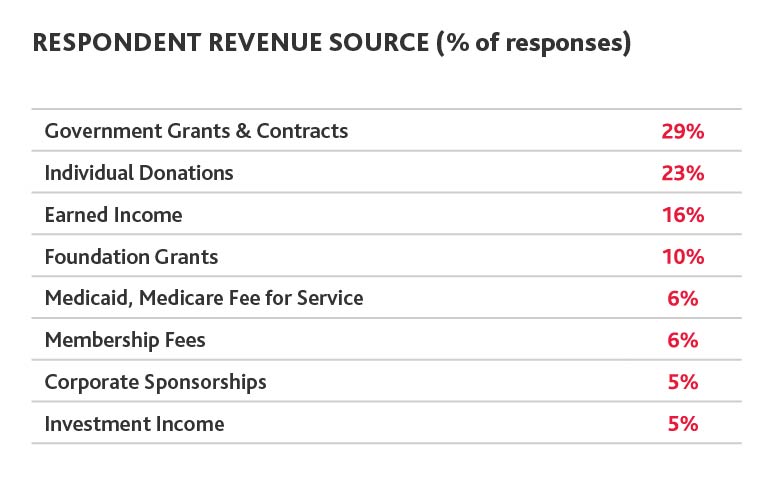Nonprofit Leaders Are Concerned About Economic Conditions, Funding Stability, and Federal Government Activity
The first quarter of 2025 proved to be a challenging time for nonprofits. Early in his tenure, President Trump issued several executive orders impacting nonprofits, including a 90-day review of foreign aid, stop work orders for current foreign aid projects, and cuts to the workforce and budgets of many government agencies, including USAID. In addition, economic uncertainty related to tariff policies has made it difficult for nonprofits to financially plan for the future. This disruption comes at a time when many nonprofits are already facing pressures to consolidate, reorganize, or rethink their organizational strategy.
To understand how nonprofit leaders are adjusting during this transitional period, BDO polled 111 nonprofit leaders from March 27 to April 25, 2025, on their top concerns for their organization. The survey was conducted online, and the sample consisted of leaders at BDO’s nonprofit clients and other organizations in BDO’s network. The full survey methodology can be found below. This is the inaugural pulse survey, with two more to come this year.
The survey found that the top concern of nonprofit leaders is the impact of economic conditions on their organization’s operations, ahead of funding stability, federal government activity, and federal funding availability.
Read on for the key takeaways from BDO’s Nonprofit Pulse Survey.
Economic Conditions Are Nonprofits’ #1 Concern
The pulse survey asked nonprofit leaders to rate their level of concern on a scale of 1 to 5, with 1 being “not concerned,” and 5 being “extremely concerned” for several key issues.
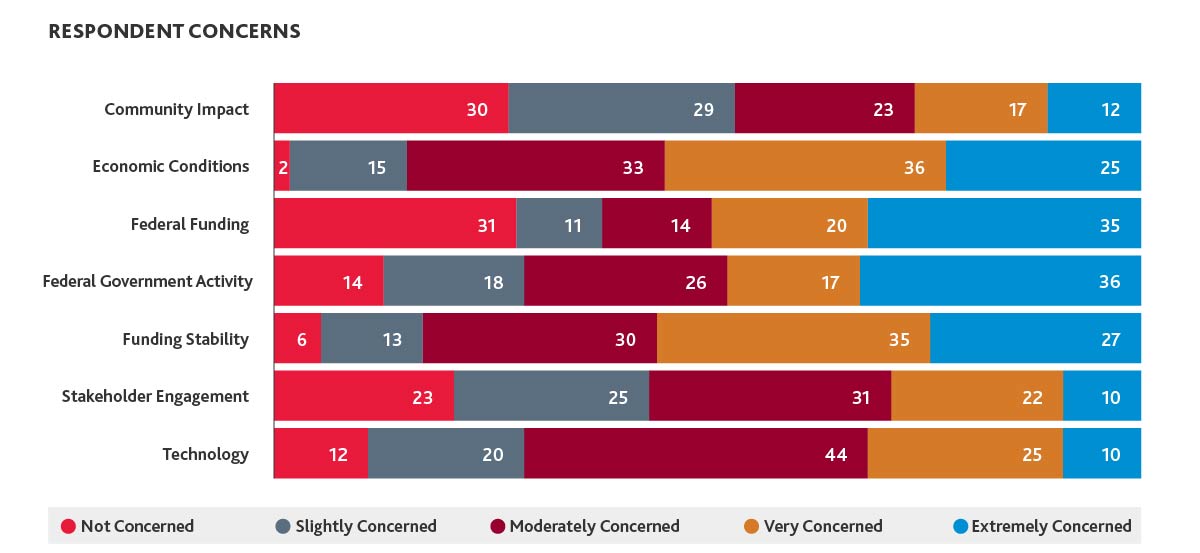
The issue that has the highest level of average concern is the impact of economic conditions on the organization’s operations. This had an average concern level of 3.6.
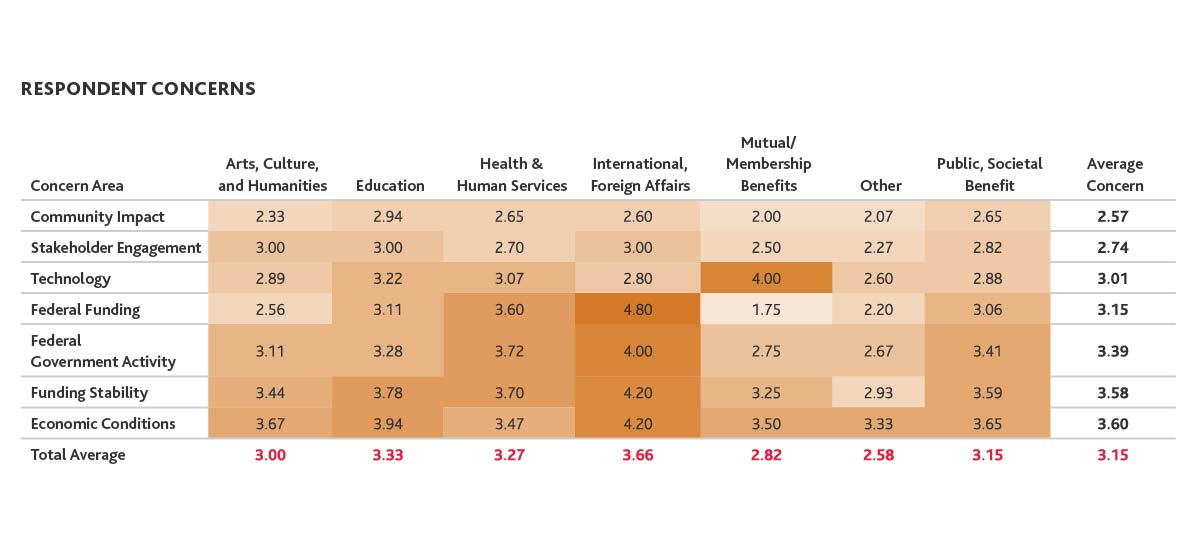
Key: |
|---|
| Respondents were asked on a scale of 1-5, with 5 being the most and 1 being the least, how concerned they are about… |
| Community Impact: Measuring and demonstrating the impact of the organization on the community. |
| Economic Conditions: The impact of economic conditions on the organization’s operations. |
| Federal Funding: Securing or maintaining federal funding in the current environment. |
| Federal Government Activity: Potential conflicts between the organization’s work and current federal policies and executive orders. |
| Funding Stability: The stability of funding sources for the organization. |
| Stakeholder Engagement: Maintaining and increasing engagement with stakeholders. |
| Technology: Keeping up with the latest technology, including AI and cybersecurity. |
An economic decline would strongly impact the ability of nonprofits to secure donors, fund programs, and plan for the long term. In addition, a downturn could increase the demand for nonprofit services, especially for organizations that help underserved populations. Concerns about the impact of economic conditions on the nonprofit sector are likely to continue to increase in Q2 2025, as BDO’s polling predates the reports that the U.S. economy shrank in Q1 2025.
Funding Stability and Federal Government Activity Are Close Behind Economic Concerns
While the impact of economic conditions on operations is the number one area of concern for nonprofits, the stability of funding sources for the organization is close behind with an average level of concern of 3.58. This may illustrate that nonprofit leaders are not only concerned about losing federal grants, but broader funding impacts. Economic uncertainty could impact the ability of individual donors to give. While some private foundations may step up their giving in response to government funding cuts, there is simply not enough private funding available to replace federal cuts.
Concern over potential conflicts between the organization’s work and current federal policies and executive orders had the third highest level of average concern at 3.39. Among those surveyed, international, foreign affairs organizations were most concerned at a 4.00. However, just 5 international, foreign affairs organizations were surveyed. The 43 health and human services organizations had the second highest level of concern over federal government activity at 3.72. These organizations are likely considering how changes at the Health and Human Services Administration (HHS) could come into conflict with their organization’s missions. In addition, possible cuts to Medicare and Medicaid could lower reimbursement rates, potentially causing financial harm.
Mutual and Membership Benefit Organizations are a Harbor in Uncertain Times
Mutual and membership benefit organizations had the lowest level of average concern of any organization at just 2.82. Because these organizations tend to rely on membership dues and fee-for-service, they are insulated from disruptions related to federal funding cuts and government activity. However, these organizations were most concerned about keeping up with the latest technology. The fact that mutual and membership benefit organizations are less impacted by current economic and political conditions means now may be the right time to invest in their technology infrastructure.
Concern About Securing or Maintaining Federal Funding is Split
The cuts to federal nonprofit grants have dominated news headlines and created challenging scenarios for organizations that heavily rely on grant funding. But many organizations may have very little federal funding, if any. As a result, some organizations are extremely concerned about securing or maintaining federal funding, while others are not concerned at all. Organizations that are funded through government grants and contracts had a 4.19 average level of concern about federal funding, whereas those that rely on earned income had a score of just 2.28.
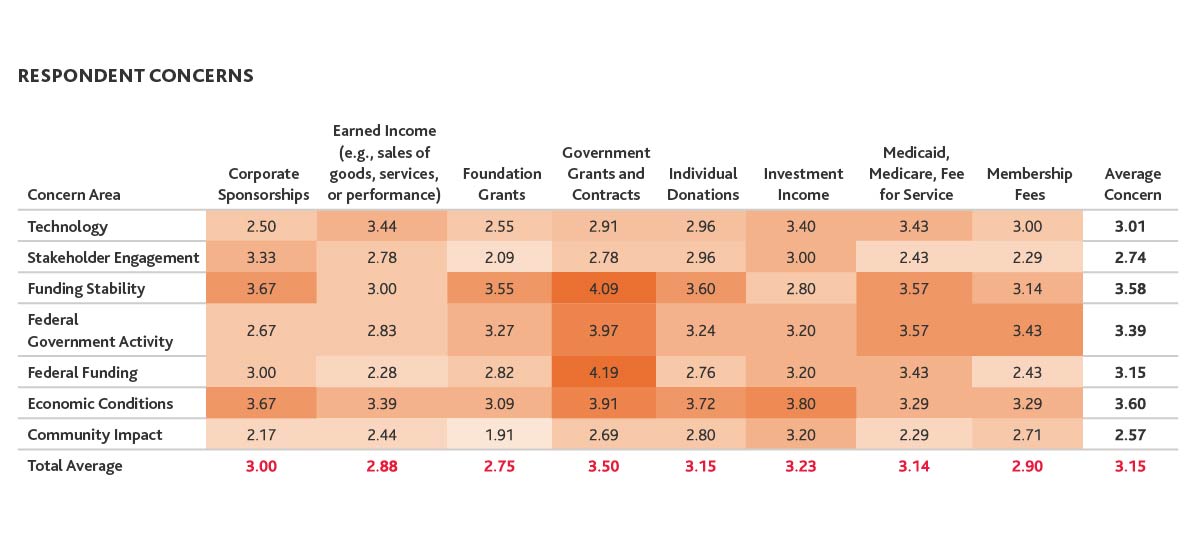
The graph below displays the difference between the mean and median in the surveyed areas of concern. Federal funding and funding stability have the greatest difference. This trend demonstrates how some organizations are highly impacted by funding stability and federal funding availability, while others are not impacted much at all.
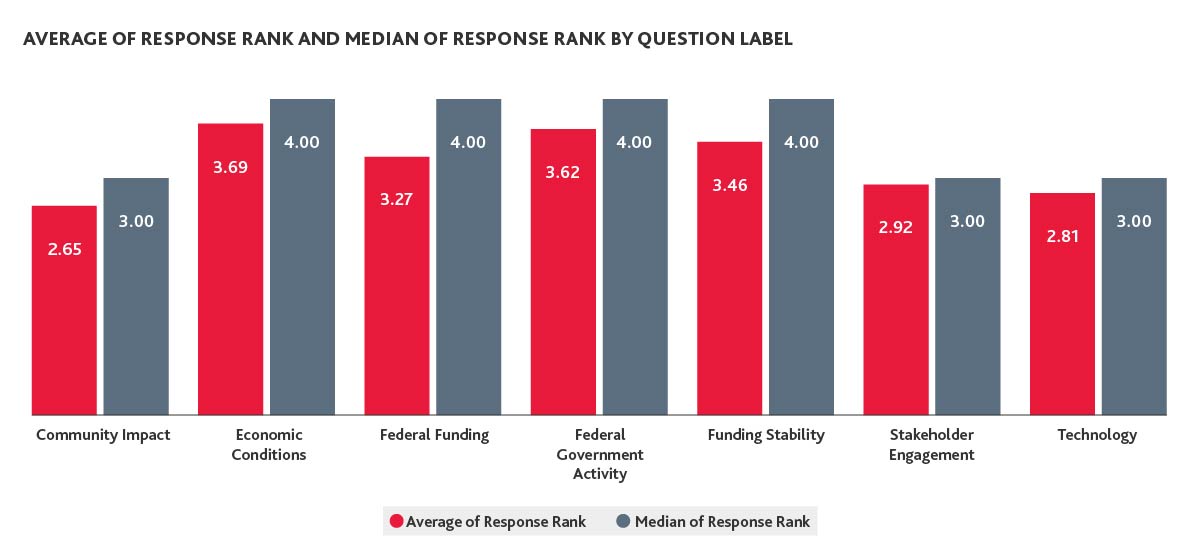
Evergreen Concerns are Placed on the Back Burner
In addition to the issues discussed above, there are other areas, such as keeping up with the latest technology, increasing stakeholder engagement, and measuring and reporting community impact, where concern by nonprofit leaders is minimal. These are typically perennial concerns of nonprofits.
Forty percent of respondents said they were “moderately concerned about keeping up with the latest technology.” This was the highest amount of “moderately concerned” selections of any response category. This suggests that upgrading technology is a concern but is not an immediate priority. Many organizations have updated their technology to adapt to shifting work and donation models during the COVID-19 pandemic and therefore may deprioritize technology upgrades in the immediate term.
Maintaining and increasing stakeholder engagement had an average level of concern of 2.74, indicating that on average this is below a moderate level of concern. Many stakeholders may have proactively increased their engagement with the organizations they support because they know that cuts to federal funding could make organizations vulnerable.
Finally, nonprofit leaders were the least concerned about measuring and demonstrating the impact of their organizations on their community, with an average concern level of just 2.57. This issue is closely tied with stakeholder engagement, as organizations frequently measure and report on their impact to engage stakeholders and increase donations. But given stakeholders may have already increased their engagement, tracking and measuring impact is less of an immediate priority.
Looking Ahead
Cuts to federal funding and uncertain economic policy have made 2025 a challenging time for nonprofits. The sector’s resilience, vibrantly demonstrated during the COVID-19 years, will come under new strain. The sector and its stakeholders will need to be creative and proactive to help organizations transition to yet another new normal.
Here are some practical steps nonprofit leaders with significant federal funding should consider:
- Plan Ahead: Develop contingency plans for delayed or reduced funding. Contingency planning should also include scenario modeling to assess how potential funding cuts will impact the organization and its operations. This type of planning can help organizations gain foresight into how processes may be affected by funding reductions. Conducting operating reserve analysis can also help nonprofit leaders understand how much to use during interim periods and identify where to invest strategically.
- Compile Documentation: Organize and assemble reporting and compliance documentation. Nonprofits should prepare for increased scrutiny around federal fund usage and should confirm proper documentation and reporting procedures.
- Understand Stop Work Orders: Take time to evaluate stop work orders and compile termination claims. Accurately recording costs incurred from an immediate project termination can help organizations recoup some lost costs.
- Stay Informed: Monitor federal communications. Staying informed about federal funding news and updates can help organizations plan ahead. Visit our federal policy hub to learn the latest.
Prepare your nonprofit for what’s next. Contact us today.
Methodology: This edition of the BDO Nonprofit Pulse Survey polled 111 BDO clients and nonprofit leaders in BDO’s network from March 27 - April 25, 2025, with revenues ranging from under $5 million to $125 million. The BDO Nonprofit Pulse Survey is designed to provide a snapshot of nonprofit concerns across the sector and includes organizations of varying revenue sizes and subsectors.
